Fixtured Self-Feed Drills: Boost Productivity with Unparalleled Precision, Consistency, and Versatility
24th Oct 2023

Time and labor efficiency are pivotal concerns for manufacturers, particularly for smaller and general industrial enterprises where feed drills find a well-suited niche. Work environments demand tools that not only occupy minimal floor space but also demonstrate exceptional reliability and durability. Programmable feed drills offer the distinct advantage of tailoring machining processes, permitting precise adjustments in speed and torque to align with a company's specific applications and materials. They serve as pillars of quality control, ensuring a consistent production output that is devoid of variability, an imperative for sustained productivity within the industrial sphere.
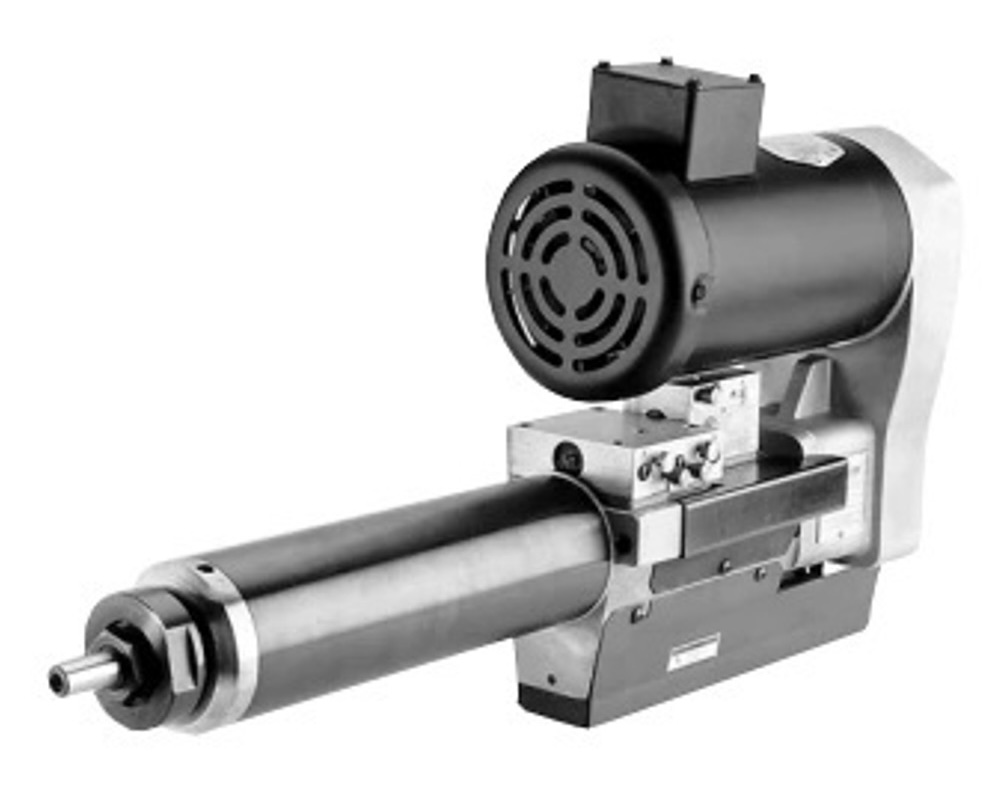
Self-Feed drills have earned their reputation as reliable workhorses, automating manufacturing processes that would otherwise rely on manual labor. These tools streamline complex assemblies, imbuing them with heightened precision, accuracy, and uniformity. Pneumatic feed drills and tappers, epitomized by industry leaders like Ingersoll Rand, a globally recognized pioneer in dependable and innovative power tools, offer cost-effective solutions that address the multifaceted challenges encountered in industrial manufacturing.
Their applications span a diverse range, encompassing tasks such as drilling rivet holes and wing frame mounting holes for aerospace applications, creating panel and frame holes for industrial-grade appliances, forming dowel holes for robust furniture constructions, and crafting precision wood and metal components for durable doors and windows. In essence, automated feed drills represent an evolutionary leap in industrial manufacturing, ushering in enhanced efficiency and precision to an unprecedented degree.
Feed Drill Manufacturing Application Setups
Let's explore a practical application scenario for feed drills, demonstrating their versatility and safety features:
- Streamlined Operator Safety: Imagine an operator in a manufacturing environment tasked with loading parts, such as a window frame, into a precision jig. To ensure utmost safety, a carefully planned setup is put into action. This setup incorporates a two-hand anti-tie-down mechanism, which necessitates the simultaneous activation of both buttons by the operator. This ingenious design effectively safeguards the operator's hands, preventing them from entering harm's way during the drilling process.
- Production Efficiency at Scale: Manufacturers can harness the potential of auto feed drills across multiple workstations, thereby optimizing their production capabilities. In fact, it's not uncommon for small to medium-sized workshops to integrate as many as 15 feed drills within their assembly plants. These drills are purpose-built to excel in production environments that demand precision and quality manufacturing. Consider the versatility of employing two feed drills simultaneously, each tasked with drilling into opposing ends of a part, efficiently creating multiple holes simultaneously. Alternatively, a sophisticated indexing table can be employed to rotate parts into predefined drill positions, ensuring precision and consistency throughout the process.

- Multi-Spindle Heads for Enhanced Efficiency: For even greater efficiency, feed drills can be equipped with multi-spindle heads, which have two distinct styles: adjustable and fixed patterns. Adjustable heads offer flexibility, accommodating various hole patterns within the capabilities of the specific head. These adaptable spindles come in configurations of two, three, and four spindles. In contrast, fixed spindle heads are custom-built to match a manufacturer's specific drill patterns, optimizing precision and repeatability.
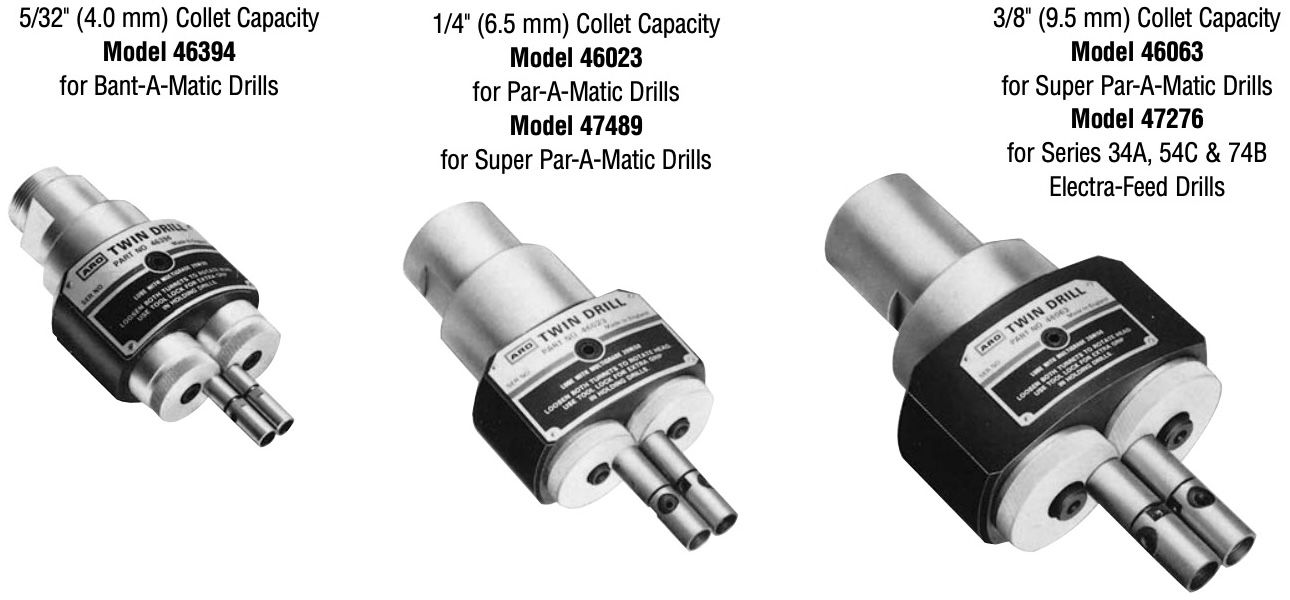
- Remote Operation and Automation: Feed drills can be seamlessly integrated into continuous operations with a focus on consistency. Automated controls can be introduced, granting operators the ability to initiate, retract, stop, and cycle the unit through a series of valves. These valves can either be conveniently located within the drill units themselves or externally for ease of access. Additionally, feed drills can be programmed for operation using various control interfaces, including actuators, hand levers, foot pedals, or other custom setups.
In essence, feed drills offer not only precision and versatility but also a range of safety and efficiency features that make them indispensable tools in modern manufacturing environments, where quality and productivity are paramount concerns.
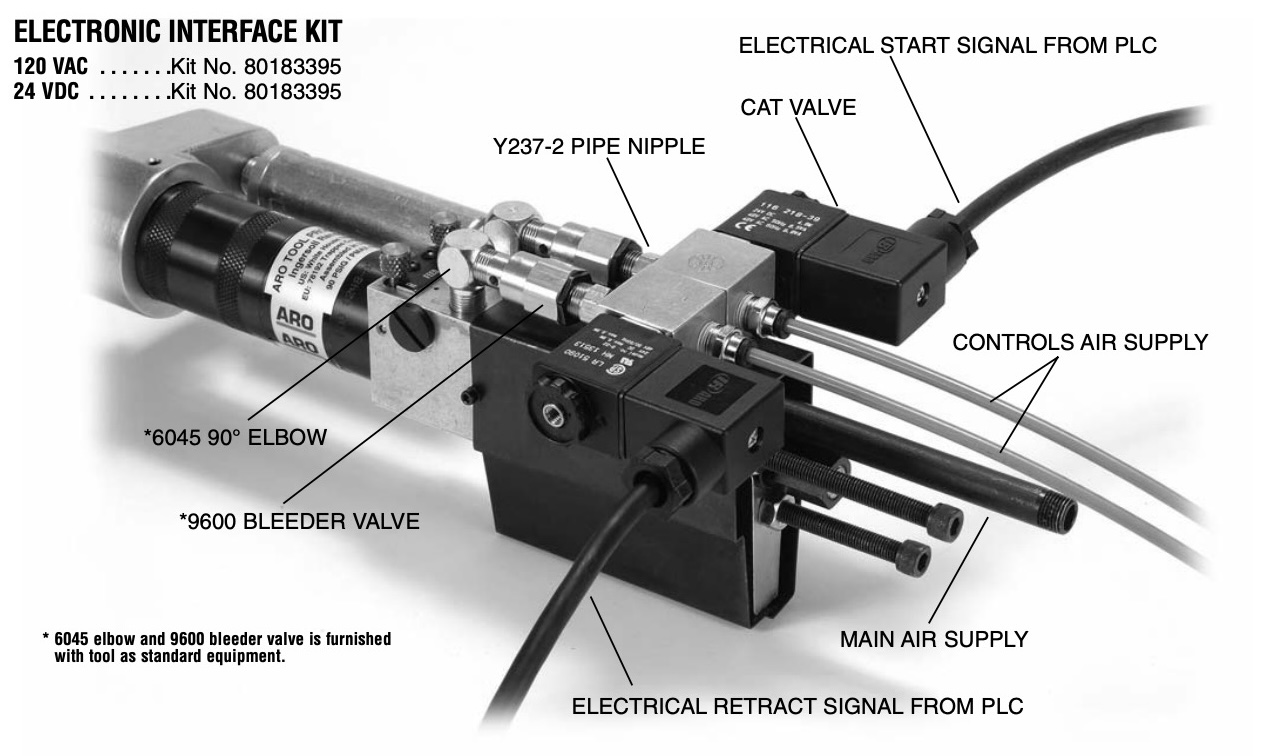
Setting Up A Self-Feed Drill
Setting up an auto feed drill may seem straightforward, but it involves a precise sequence of steps to ensure smooth and safe operation. Let's delve into the process:
- Measure and Assess: Commencing the setup requires a careful measurement of the distance between the drill point and the workpiece. This crucial initial step lays the foundation for a precise operation.

- Mounting Bracket Adjustment: The next phase involves adjusting the mounting bracket on the hydraulic check. The goal is to set it in a way that the distance between the hydraulic check plunger and the trip bracket is shorter than the distance between the drill point and the workpiece. This critical adjustment prevents any unwanted collision between the drill point and the workpiece, ensuring both tool and material integrity.
Note: The ARO Tubular Mounting System is an extremely versatile method of mounting ARO Bant-A-Matic, Par-A-Matic, and Super Par-A-Matic Series tools. Available mounting components accommodate endless fixture requirements and permit the positioning of tools at virtually any angle to the workpiece. The following illustrations show just a few examples of the many fixture possibilities.
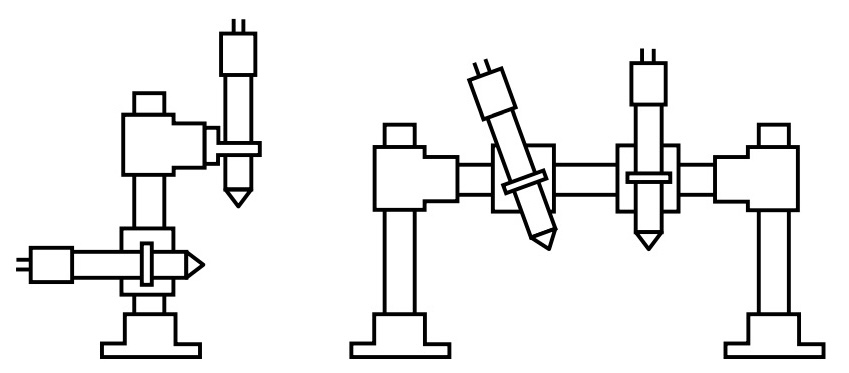
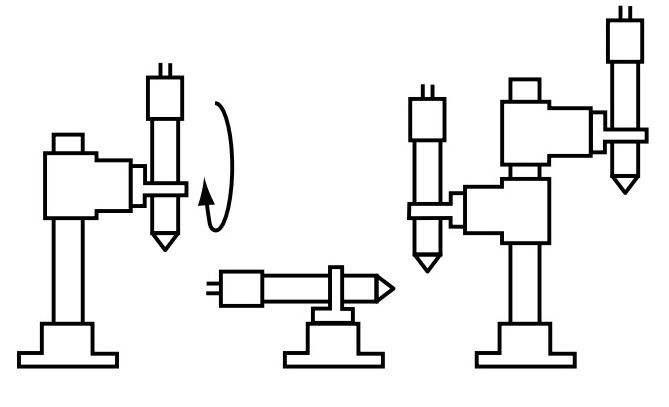
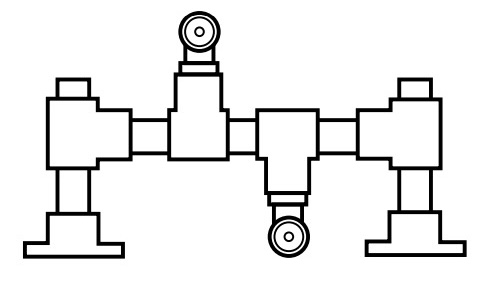
- Feed Rate Configuration: Once the mounting bracket is in its optimal position, the focus shifts to adjusting the feed rate. This is achieved by carefully rotating the extended spindle on the hydraulic check. The aim is to position the slot on the spindle midway between the highest and lowest settings. Achieving this balance is vital for precise control during drilling.
 Tool Activation: With the setup nearing completion, it's time to start the tool. The drill advances rapidly until the trip bracket makes contact with the plunger of the hydraulic check. This contact point serves as a pivotal moment, signifying that the setup is progressing as intended.
Tool Activation: With the setup nearing completion, it's time to start the tool. The drill advances rapidly until the trip bracket makes contact with the plunger of the hydraulic check. This contact point serves as a pivotal moment, signifying that the setup is progressing as intended.
- Hydraulic Feed Control Fine-Tuning: To achieve the desired drilling rate, the final step involves a gradual clockwise rotation of the hydraulic feed control. This adjustment continues until the tool advances at the precise rate required for the specific task at hand, aligning with the Zero ("0") mark on the nameplate.
In mastering these setup steps, operators ensure the efficient and safe operation of auto feed drills, paving the way for accurate and reliable manufacturing processes.
Feed Rate Adjustment Of A Fixtured Drill
The feed rate adjustment performed by the drill operator is a crucial aspect of the process and is contingent upon various factors, primarily the type of materials employed for the application. These materials can range from mild or hard steel to aluminum, wood, plastics, fiberglass, or other specialized substances. Additionally, the dimensions of the hole to be drilled play a pivotal role in determining the necessary parameters.
 Material Considerations: The choice of feed rate is intricately tied to the material being worked on. Materials with varying degrees of hardness and properties necessitate specific feed rates for optimal results. For instance, the operator must calibrate the feed rate differently when working on robust steel compared to the more delicate nature of wood or plastics.
Material Considerations: The choice of feed rate is intricately tied to the material being worked on. Materials with varying degrees of hardness and properties necessitate specific feed rates for optimal results. For instance, the operator must calibrate the feed rate differently when working on robust steel compared to the more delicate nature of wood or plastics.
- Hole Specifications: The size of the hole to be drilled is another determinant in this process. The dimensions of the hole dictate the amount of horsepower required to effectively penetrate the material. Similarly, the depth of the hole governs the length of the drill stroke required for successful completion of the task. Special attention is given to differentiating between blind hole drilling, where the hole terminates within the material, and thru hole drilling, where the hole spans the entire material.
- Thread Tapping Expertise: Feed drills are frequently employed for hole tapping, a ubiquitous application in manufacturing. Tapping is the intricate process of carving threads into a hole to accommodate specific thread pitch and screw diameter requirements. This involves meticulous consideration of the number of threads per inch and their precise alignment.
Furthermore, it's essential to note that there are two prevalent threading standards: the U.S. and Metric systems. These systems diverge not only in their use of inch versus metric measurements but also in the definition of thread pitch itself. In the U.S. system, thread pitch is quantified as the number of threads per inch (TPI). Conversely, the metric system characterizes thread pitch as the distance from one thread to the next, introducing a distinct approach to thread measurement.
By comprehending and tailoring these critical parameters, drill operators can navigate the complexities of feed rate adjustment and threading processes, ensuring the flawless execution of their manufacturing tasks across a spectrum of materials and specifications.

Ingersoll Rand Feed drills are available in many configurations:
ARO, a distinguished brand under the Ingersoll Rand umbrella, boasts a comprehensive portfolio comprising of Bant-A-Matic, Par-A-Matic, Super-Par-Matic clutch-type, and High-Thrust Series pneumatic feed drills. These versatile tools cater to both manual and remote operations, facilitating drilling, reaming, counter-sinking, counter-drilling, and tapping across a wide spectrum of materials.
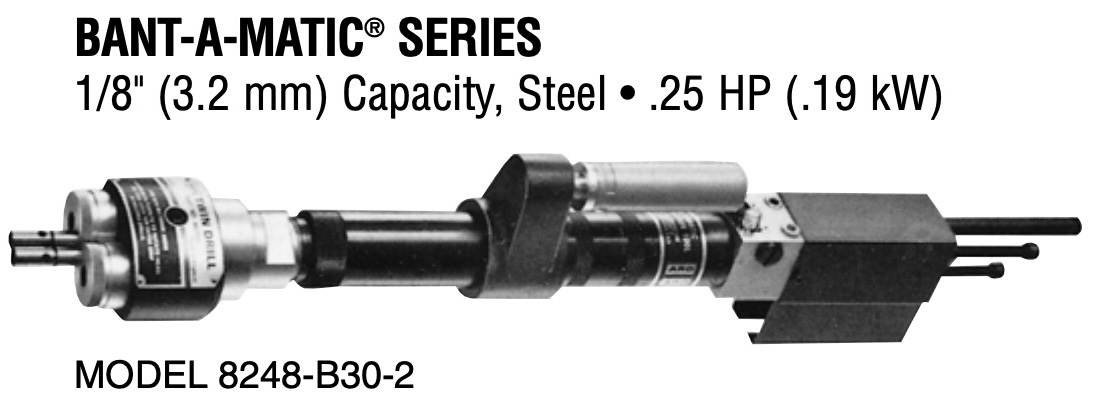


The Bant-A-Matic, Par-A-Matic, and Super-Par-A-Matic Series excel in providing the requisite versatility, performance, and precision to automate a wide range of secondary machining tasks. These tools incorporate reliable rotary-vane air motors, delivering an exceptional power-to-size ratio that minimizes tool dimensions and weight, thereby enhancing machine design flexibility. Installation is a breeze, requiring only basic pneumatic circuitry.
 For applications demanding heightened material removal rates from standard alloys to non-ferrous materials, the ARO High-Thrust 8670 Series automatic feed drills take center stage. With their formidable power and thrust capabilities, they rise to the challenge of machining even the most demanding materials, including titanium and high-nickel alloys.
For applications demanding heightened material removal rates from standard alloys to non-ferrous materials, the ARO High-Thrust 8670 Series automatic feed drills take center stage. With their formidable power and thrust capabilities, they rise to the challenge of machining even the most demanding materials, including titanium and high-nickel alloys.
These Hi-Thrust drills are equipped with a dual piston system that generates an impressive thrust of 500 pounds, enabling rapid penetration and reduced cycle times. Moreover, they operate fully automatically, with all cycle and motor functions efficiently regulated by a single control module.
![]() Looking for more information about Ingersoll Rand Self Feed Drills ? Click here to view the Catalog
Looking for more information about Ingersoll Rand Self Feed Drills ? Click here to view the Catalog
For help choosing the correct Drill for your application, please call (800) 608-5210 or email info@intlairtool.com


